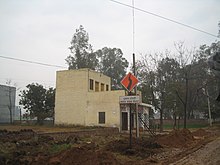National Advisory Council
| National Advisory Council | |
|---|---|
 | |
| Sonia Gandhi and the fourteen members | |
| Agency overview | |
| Formed | June 2004 |
| Jurisdiction | Government of India (Union Government) |
| Headquarters | New Delhi |
| Agency executive | Sonia Gandhi, Chairman |
| Website | |
| Official site | |
The National Advisory Council (NAC) of India is an advisory body set up to monitor the implementation of the UPA government's manifesto, the Common Minimum Programme(CMP). It is a brainchild of Congress party president, Sonia Gandhi. It is also informally called as UPA's Planning Commission for social agenda. On 23 March 2006, Sonia gandhi had resigned from the post of chairmanship of the NAC after Office of profit controversy. On 29 March 2010, she was back as the chairperson of NAC.
Contents[hide] |
[edit]History
NAC was set up on 4 June 2004 by Prime Minister Manmohan Singh, during UPA-I, to implement the National Common Minimum Programme, or CMP. [1]
[edit]Organisation
The leader of the Congress party, Sonia Gandhi is the chairperson of NAC, holding the status of a cabinet minister. The other members of this council are nominated by the prime minister in consultation with the chairperson. The funds for the functioning of this council are provided from the budgetary allocation for the Prime Minister's Office.
[edit]NAC - II (2010 - present)
The NAC - II is a mix of activists, retired bureaucrats, economists, politicians and an industrialist.
- Sonia Gandhi - Chairman
- Prof. M.S. Swaminathan - Agricultural scientist and MP
- Dr. Ram Dayal Munda - MP
- Aruna Roy - Retired bureaucrat
- Jean Dreze - Development economist
- Narendra Jadhav - former bureaucrat & Member, Planning Commission
- Harsh Mander - Retired Bureaucrat
- Prof. Pramod Tandon - Vice Chancellor, North Eastern Hill University
- Deep Joshi - Social activist
- Madhav Gadgil - Ecologist
- Farah Naqvi - Social activist
- Dr. N. C. Saxena - former bureaucrat
- Anu Aga - Businesswoman
- A. K. Shiva Kumar - Economist[2]
- Mirai Chatterjee - Coordinator, SEWA, Ahmedabad
The NAC secretariat has Rita Sharma as its Secretary.[3][4]
[edit]Focus areas
|
|
[edit]NAC - I (2004 - 2006)
- Sonia Gandhi - Chairman UPA and Congress party president
- M.S. Swaminathan - Agricultural scientist
- Aruna Roy - Social activist
- Jean Dreze - Development economist
- C.H. Hanumantha Rao - Economist
- Madhav Chavan - Educator, founder Pratham
- Sehba Hussain - Founder, Self-Employed Women's Association (SEWA)
- A. K. Shiva Kumar - Economist
- Jairam Ramesh - Politician
- Jayaprakash Narayan (Lok Satta) - Politician and former bureaucrat
- V. Krishnamurthy
- Dr. N. C. Saxena - former bureaucrat
- Mrinal Miri - Educator
[edit]Achievements
The RTE act neglected the constitutional rights of tribal councils in north east India, which are the bodies having controlling powers over Elementary Education in their respective areas.
[edit]Criticisms
The NAC has been criticized by opposition parties and scholars as not in keeping with India's constitution, and that it would emerge as an alternative, unelected cabinet. [5][6][7][8]


